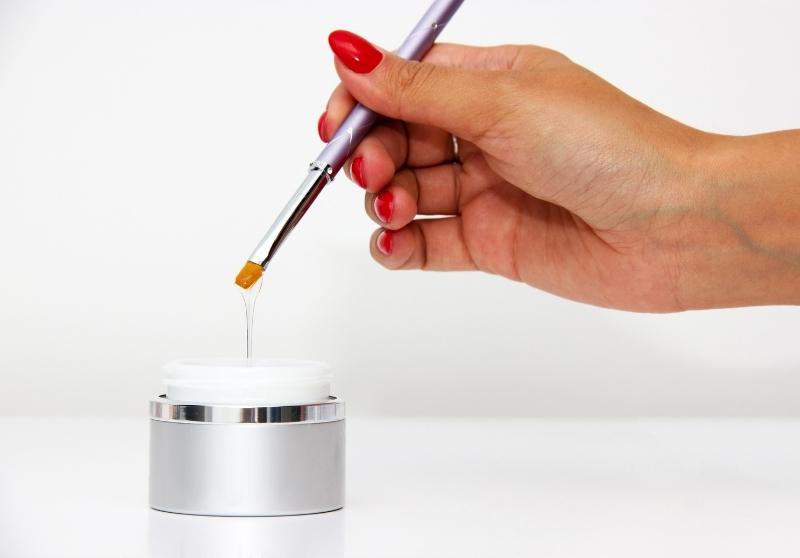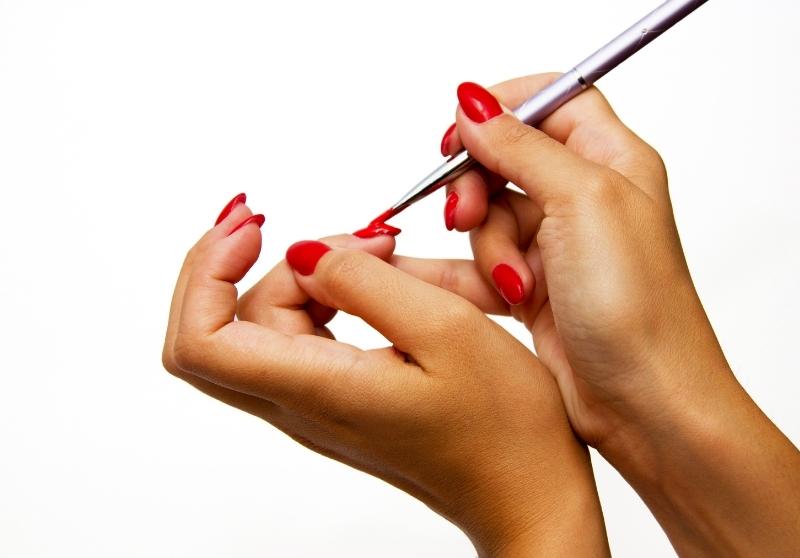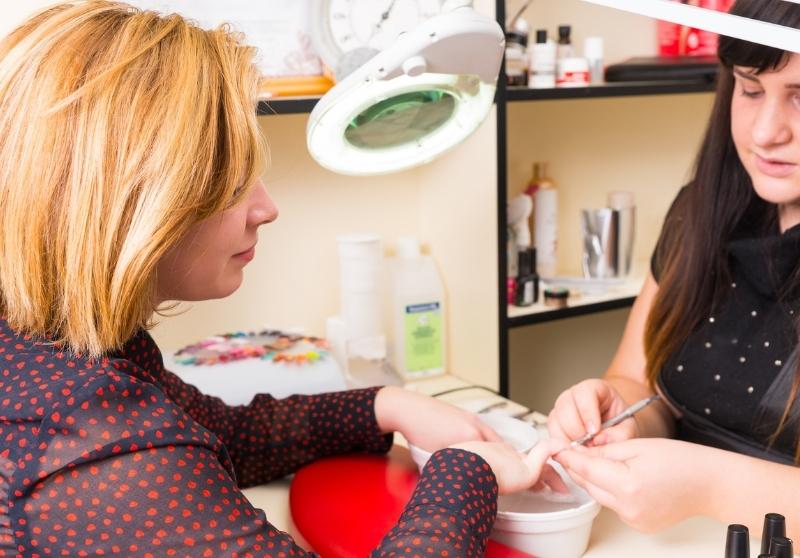If you’re a fan of the length that acrylic extensions afford, then you may be wondering whether you can use a dip powder on fake nails for that added length. In this article, we explain just how that is possible and how you should go about it.

Yes, you can use dip powder on fake nails. Dip powder works perfectly well on fake nails. You can apply either full fake nails or fake nail tips to your natural nail, buff away any uneven texture, and follow the standard dip powder manicure procedure.
What Is Dip Powder?
Dip powder manicures – also known as SNS (signature nail system) nails – are a newly popular alternative to gel and acrylic manicures. T
hink of them as something like a hybrid of the two.
Different dip powders have different consistencies and textures. Different brands will also offer dip powder in various finishes and colors.
Dip powder manicures can be achieved either at home or in a salon. They can take anywhere from half an hour to twenty minutes.
If you’re unfamiliar with the process, we recommend heading to a salon.
Although dip powder manicures are less chemically intensive than acrylics, and don’t require the UV light of a gel manicure, they do still involve chemicals.
Therefore they are best done under supervision for the sake of caution.
Dip powder manicures use a sealant to lock down the color. This is typically like a resin in texture and look, but is odorless.
Unlike a gel manicure, dip powder manicures also don’t need UV light, so are better for the skin’s health overall.
There’s also no need for the monomer that acrylic manicures require.
This monomer can cause sensitivities in some people. This is why dip powder manicures may be preferable in these instances.
How Is Dip Powder Applied?
As the name suggests, a dip powder manicure involves dipping your nail into a pot of finely milled, dust-like powder.
A sealant is then placed on top of the dip powder in order to lock the color in, along with a top coat.
That said, if you’re getting a dip powder manicure in a salon, your nails likely won’t be dipped into a pot, as this is considered unsanitary.
The powder will either be brushed onto each nail, with the excess tapped off, or decanted into another container, into which your nails will be dipped.
You should not pay for a procedure where your nail is dipped into a pot used by other customers.
Can I Use Dip Powder On Fake Nails?

Yes, you can use dip powder on fake nails. Simply apply the fake nails onto your natural nails following manufacturer instructions, before following the below procedure for applying dip powder.
Part of the appeal of dip powder is that it can also be used on fake nail extensions or tips.
So, if you’ve always turned to acrylics as a strategy for lengthening your natural nails, but don’t love the number of chemicals involved in doing so, then you can swap to nail extensions or tips.
In fact, dip powder is lighter in weight than acrylic, so it looks more natural and usually withstands more wear and tear than acrylic manicures.
Simply add the fake tips or extensions to your natural nails before following the below procedure for applying dip powder.
How To Use Dip Powder On Fake Nails
1. Apply your fake nails
Ready your fake nails or tips to apply them, ensuring that you have all of the necessary kit and equipment.
Ensure that your regular nails are clean and dry before applying your fake nails or artificial nail tips to your natural nails.
Always follow manufacturer instructions when applying your fake nails.
A good tip when applying fake nail extensions and following up with a dip powder manicure is to buff the entire nail.
Do both the natural and the fake tip – in order to create an even base onto which to apply the dip powder.
This will help to reduce any build-up of thickness or excess powder. Just remember not to over-buff your nails, as this will thin them and may result in breakage.
2. Add your bond coat
Once your fake nails or tips have been applied, you can sweep a layer of bonding coat onto each nail.
Remember to leave this to dry for a minute or so, before dipping each individual nail into the dip powder.
Remember to always brush any excess powder off, so as to reduce the risk of uneven thickness or texture.
You may need to dip your nails a number of times in order to achieve the look that you’re going for.
3. Apply a sealant
Once you are content with the look of your dip powder manicure, you can apply the odor-less resin-like sealant on top of the dip powder.
This works to lock in the color. You can use a fan dryer in order to speed up the drying process if preferred.
You can also add a top coat on top of this if you’d like to add extra protection. Just ensure that you only do so once the dip powder and sealant are thoroughly dry.
If you are struggling with this part, read our post on What To Do When Dip Nails Won’t Dry.
What Is The Difference Between Dip Powder And Acrylic?

Dip powder and acrylic powder are often described and advertised as the same product.
There are real similarities between the two, but they are not the same. Their consistency, texture, and ingredients vary.
As a result, you’ll end up with very different looks between a dip powder and an acrylic powder manicure.
Difference In Ingredients
Typically, both substances contain acrylic ester polymers. However, unlike acrylic powder, dip powder doesn’t require a monomer in order to set its bonds.
Dip powder is sealed with an odorless resin-like sealant, whereas acrylic powder requires this strong-smelling chemical in order to work.
Dip powder can therefore appeal to those who find the monomer either unappealing for its strong smell or are irritated by its properties.
Difference In Texture
Whilst both dip powder and acrylic powder are finely milled and dust-like in texture, dip powder will typically be less coarse than acrylic powder.
Nails manicured with acrylic powder can therefore feel and look thicker, and therefore less natural, than those with a dip powder manicure.
Difference In Lasting-Ability
Dip powder manicures tend to last longer than acrylic manicures, as the dip powder process produces a stronger manicure overall.
Dip powder nails can last anywhere up to six weeks, compared to the usual two weeks of an acrylic manicure.
It differs from gel manicures because gel manicures require you to put your nails under a UV lamp in order to set and solidify the gel.
Can You Use Dip Powder With Acrylic Liquid?
You can use dip powder with acrylic liquid, but remember that you may not get the results that you anticipated.
Acrylic powder is designed for use with acrylic liquid, and, as such, will work best.
You may need to dip your nails more when using dip powder with acrylic liquid, compared to when using acrylic powder.
You may also need to prepare your nails better, refining, shining, shaping, and buffing nails before using either the dip powder or acrylic liquid.
Two-in-one dip and acrylic products may be a better alternative for those who are confused about distinguishing the two formulas.
How Long Does Dip Powder Last?

If you take care of your dip powder manicure, then it can last for anywhere up to a month.
Remember, if you regularly expose your nails to strong chemicals, then the manicure won’t last as long.
When you’re washing the dishes or cleaning using strong formulas, remember to wear gloves so as to protect your dip powder manicure.
If you can use a cuticle oil and hand cream regularly, this will also help to keep your hands as healthy as possible and will ensure the manicure lasts as long as possible.
Is Dip Powder Easy To Remove?
Dip powder manicures can be easy to remove.
You want to take a nail buffer or file and buff away any shine on your nails. Once this is done, take a bowl of acetone.
You need to soak your nails for ten to fifteen minutes in order to remove the dip powder.
Don’t pick or peel at your dip powder, even if the acetone doesn’t result in total color removal.
You may need to head to a nail technician if the acetone treatment doesn’t result in full dip powder removal, so as to minimize the risk of long-term damage to your nails.
